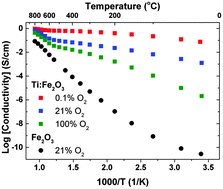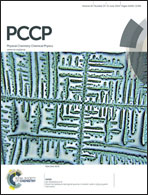The electrical conductivity of thin film donor doped hematite: from insulator to semiconductor by defect modulation†
Abstract
Hematite or α-Fe2O3 has emerged as a highly promising photoanode candidate for photoelectrochemical cells. While significant improvements in its performance have recently been achieved, it remains unclear why the maximum photocurrents still remain well below their theoretical predictions. Here, we report, for the first time, a detailed correlation between the electrical conductivity of undoped and 1 atom% Ti doped hematite and the conditions under which it was annealed (20 ≤ T ≤ 800 °C and 10−4 ≤ pO2 ≤ 1 atm). Hematite thin films grown by pulsed laser deposition onto sapphire single crystals were evaluated by impedance spectroscopy. Hematite's room temperature conductivity can be increased from ∼10−11 S cm−1 for undoped films by as much as nine orders of magnitude by doping with the Ti donor. Furthermore, by controlling the non-stoichiometry of Ti-doped hematite, one can tune its conductivity by up to five orders of magnitude. Depending on processing conditions, donor dopants in hematite may be compensated largely by electrons or by ionic defects (Fe vacancies). A defect model was derived to explain this phenomenon. In addition, a temperature independent value for the electron mobility of 0.01 cm2 V−1 s−1 for a donor density of 4.0 × 1020 cm−3 (1% Ti) was derived. These results highlight the importance of carefully controlling photoanode processing conditions, even when operating within the material's extrinsic dopant regime, and more generally, provide a model for the electronic properties of semiconducting metal oxide photoanodes.


 Please wait while we load your content...
Please wait while we load your content...